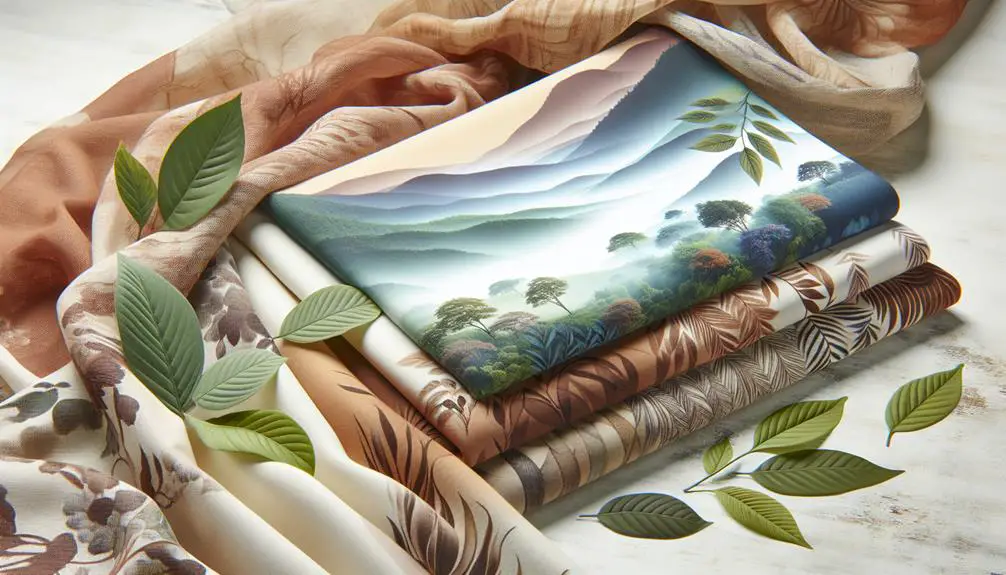You might wonder if biodegradable and compostable fabrics truly represent the future of sustainable fashion. By examining the environmental impact and practical benefits of these materials, you can better understand their potential to revolutionize the industry. From organic cotton to bamboo, these fabrics promise not only to decompose naturally but also to enrich the soil, reducing landfill waste and lowering carbon footprints. As you explore the nuances between biodegradable and compostable fabrics, you'll discover why embracing these materials is an essential step toward a more ethical and environmentally friendly fashion landscape.
Table of Contents
Key Takeaways
- Biodegradable fabrics break down naturally through microorganisms without specific conditions and decompose within months to a few years.
- Compostable fabrics require specific composting conditions to break down into non-toxic components like humus, water, and carbon dioxide.
- Organic cotton, hemp, Tencel, and bamboo are prominent eco-friendly fabrics in sustainable fashion, being biodegradable and/or compostable.
- Biodegradable fabrics minimize landfill accumulation, lower carbon footprints, and promote sustainable fashion by using fewer resources during production.
- Compostable fabrics enhance soil quality, decrease landfill mass, and support sustainable brands by using renewable materials and lowering carbon emissions.
Understanding Biodegradable Fabrics
Biodegradable fabrics are materials that break down naturally through the action of microorganisms, returning to the environment without leaving harmful residues. When you choose biodegradable fabrics, you're not just opting for a sustainable option; you're actively contributing to the reduction of waste in landfills. These fabrics can decompose within months to a few years, depending on environmental conditions, minimizing their environmental footprint.
One of the most significant environmental benefits of biodegradable fabrics is their ability to reduce pollution. Since they don't require incineration or long-term storage, they help cut down on greenhouse gas emissions and toxic byproducts that can arise from traditional waste management methods.
Additionally, these fabrics often come from renewable sources, further reducing the dependency on synthetic, petroleum-based materials.
Understanding Compostable Fabrics
Did you know that compostable fabrics not only break down naturally but also enrich the soil with nutrients as they decompose? Unlike some materials that simply vanish without a trace, compostable fabrics offer a dual benefit: they dissolve efficiently and contribute positively to the environment.
When you choose compostable fabric decomposition, you're opting for a process that's both quick and beneficial. These eco friendly textiles are designed to decompose under composting conditions, which include a balanced mix of heat, moisture, and microorganisms.
To truly understand compostable fabrics, you need to grasp their lifecycle. After serving their purpose, these fabrics get added to compost piles where they break down into humus, water, and carbon dioxide. This decomposition enriches the soil, making it more fertile.
Whether made from organic cotton, hemp, or bamboo, compostable fabrics are a cornerstone of sustainable fashion.
Furthermore, using compostable fabrics reduces landfill waste, conserves resources, and lowers your carbon footprint. As someone aiming for mastery in eco-conscious living, incorporating compostable textiles into your wardrobe or product line is a powerful step. You're not just wearing clothes; you're making a statement for a healthier planet.
Key Differences Between Biodegradable and Compostable
While both biodegradable and compostable fabrics contribute to environmental sustainability, it's important to understand the key differences between them.
Biodegradable fabrics break down naturally over time through the action of microorganisms, without specific conditions. This decomposition process can occur in various environments, including landfills, leading to less environmental impact. However, the time frame for complete material breakdown varies widely and isn't always rapid.
In contrast, compostable fabrics require specific conditions to decompose, typically found in industrial composting facilities. Compostable materials break down into non-toxic components like water, carbon dioxide, and biomass within a set period, usually under controlled conditions. This guarantees a more predictable and environmentally friendly decomposition process.
When you consider environmental implications, compostable fabrics often have an edge due to their stringent breakdown criteria. However, they lack the flexibility of biodegradable fabrics, which can decompose in more diverse settings.
Regarding recycling options, biodegradable fabrics may offer more versatility since they don't require specialized composting sites. Understanding these differences helps you make informed choices about the fabrics you use, ultimately aiding in reducing environmental harm and supporting sustainable practices.
Benefits of Biodegradable Fabrics
Given their ability to break down naturally in various environments, you'll find that biodegradable fabrics offer significant environmental benefits. By choosing these materials, you're contributing to a more sustainable fashion industry and reducing your ecological footprint. Biodegradable fabrics decompose without releasing harmful toxins, making them a superior choice for eco friendly materials.
Consider these key benefits:
- Reduced Waste: Biodegradable fabrics minimize landfill accumulation, lessening the burden on waste management systems.
- Lower Carbon Footprint: Producing biodegradable textiles typically requires less energy and generates fewer greenhouse gases compared to conventional fabrics.
- Non-Toxic Breakdown: Unlike synthetic fibers, biodegradable materials break down into non-toxic elements, ensuring they don't harm the environment.
- Resource Efficiency: These fabrics often use fewer resources, such as water and chemicals, during production, promoting a more sustainable approach.
Benefits of Compostable Fabrics
When you choose compostable fabrics, you're helping reduce environmental impact by minimizing waste in landfills.
These fabrics break down naturally, returning nutrients to the soil and conserving natural resources.
Environmental Impact Reduction
Switching to compostable fabrics greatly decreases environmental pollution by breaking down naturally instead of lingering in landfills. When you embrace compostable materials, you contribute to waste reduction and bolster recycling initiatives.
Unlike traditional synthetic fabrics, which can take centuries to decompose, compostable fabrics return to the earth swiftly, enriching the soil instead of polluting it.
Adopting compostable fabrics also promotes green manufacturing and eco-friendly practices. These fabrics are often produced using sustainable methods that minimize energy and water consumption. By opting for these environmentally responsible choices, you can help reduce the carbon footprint of the textile industry.
Consider the specific benefits of compostable fabrics:
- Decreased landfill mass: Reduced accumulation of non-degradable waste.
- Enhanced soil quality: Nutrients from decomposed fabrics improve soil health.
- Lower carbon emissions: Cutting down on waste processing and decomposition.
- Support for sustainable brands: Encouraging businesses to adopt eco-friendly practices.
Natural Resource Conservation
Compostable fabrics conserve natural resources by using renewable materials and reducing the need for synthetic production. When you choose these fabrics, you're opting for sustainable sourcing that minimizes the environmental footprint.
Traditional textiles often rely on non-renewable resources like petroleum, leading to significant ecological damage. In contrast, compostable fabrics are typically derived from plants, which can be regrown seasonally, ensuring a constant supply without depleting the earth's natural reserves.
Eco friendly production processes further enhance the benefits of compostable fabrics. These production methods often require less water and energy compared to conventional fabric manufacturing. By prioritizing eco friendly production, these fabrics help reduce greenhouse gas emissions, contributing to the fight against climate change.
You'll find that compostable fabrics often avoid harmful chemicals and pesticides, promoting healthier ecosystems and reducing soil degradation.
Moreover, when these fabrics reach the end of their life cycle, they decompose naturally, returning valuable nutrients to the soil. This process not only enriches the earth but also eliminates the waste associated with traditional textiles.
Popular Biodegradable and Compostable Fabrics
Many popular fabrics are both biodegradable and compostable, making them excellent choices for eco-friendly fashion. When you're looking for sustainable alternatives, consider these fabrics that not only reduce environmental impact but also offer style and comfort. By choosing these eco-friendly choices, you can make a significant difference in the fashion industry's footprint.
- Organic Cotton: This fabric is grown without harmful pesticides and chemicals, making it a top choice for sustainability. It decomposes naturally and adds nutrients back into the soil.
- Hemp: Known for its durability and minimal water requirements, hemp is an excellent sustainable alternative. It grows quickly and enriches the soil, making it a win-win for the environment.
- Tencel (Lyocell): Made from sustainably sourced wood pulp, Tencel is biodegradable and compostable. It's produced using a closed-loop process, ensuring minimal waste and energy usage.
- Bamboo: This fast-growing plant requires no pesticides and very little water. Bamboo fabric is both biodegradable and compostable, making it an ideal choice for eco-conscious consumers.
Future of Sustainable Fashion
As you explore these eco-friendly materials, it's clear that the future of sustainable fashion holds exciting innovations and opportunities for reducing the industry's environmental impact.
Ethical manufacturing is becoming a cornerstone, ensuring that the entire lifecycle of a garment—from production to disposal—is environmentally responsible and humane.
Designers are embracing innovative designs that prioritize both style and sustainability, creating pieces that aren't only fashionable but also biodegradable and compostable.
Consumer awareness is rapidly growing, with shoppers demanding more transparency and responsibility from the brands they support. You're likely to see increased emphasis on educating consumers about the benefits of sustainable fashion, empowering them to make informed choices.
This shift is essential for the transformation towards a circular economy, where products are designed to be reused, repaired, and recycled, minimizing waste and resource consumption.
In this evolving landscape, your role as a discerning consumer is crucial. By choosing brands committed to ethical manufacturing and innovative designs, you contribute to a greener future.
The future of sustainable fashion isn't just a trend; it's a necessary evolution, driven by informed choices and a collective commitment to preserving our planet.
Frequently Asked Questions
How Can Consumers Identify Truly Biodegradable and Compostable Fabrics?
Imagine you're exploring a forest of fabric options; certification standards act as your compass. Look for labels like GOTS or Oeko-Tex to guarantee eco-friendly options. These certifications guide you to truly biodegradable and compostable fabrics.
What Certifications Should I Look for in Biodegradable and Compostable Fabrics?
Look for certifications like GOTS, Cradle to Cradle, and OEKO-TEX. These guarantee low environmental impact through a rigorous certification process. They confirm sustainable fashion practices and responsible material sourcing, giving you confidence in your choices.
Are There Any Care Instructions Specific to Biodegradable and Compostable Fabrics?
Yes, there are specific care instructions. Follow washing guidelines like using cold water and gentle detergents. For storage recommendations, keep them in a cool, dry place to maintain their integrity and prolong their lifespan.
How Do Biodegradable and Compostable Fabrics Impact the Cost of Clothing?
Like a ripple in a pond, biodegradable fabrics can increase clothing costs initially due to market demand and sustainability benefits. However, their long-term environmental impact and affordability improve as consumers prioritize eco-friendly choices.
Can Biodegradable and Compostable Fabrics Maintain Durability and Comfort?
Yes, you can find fabrics that balance sustainability vs performance. These materials often meet both durability and comfort standards, ensuring that environmental impact vs comfort remains ideal for eco-conscious consumers without sacrificing quality.
- How Does Ring Spun Cotton Affect Garment Fit and Shape Retention? - August 13, 2024
- What Are the Challenges in Producing Ring Spun Cotton? - August 13, 2024
- Is Ring Spun Cotton Suitable for Plus-Size Clothing? - August 13, 2024





